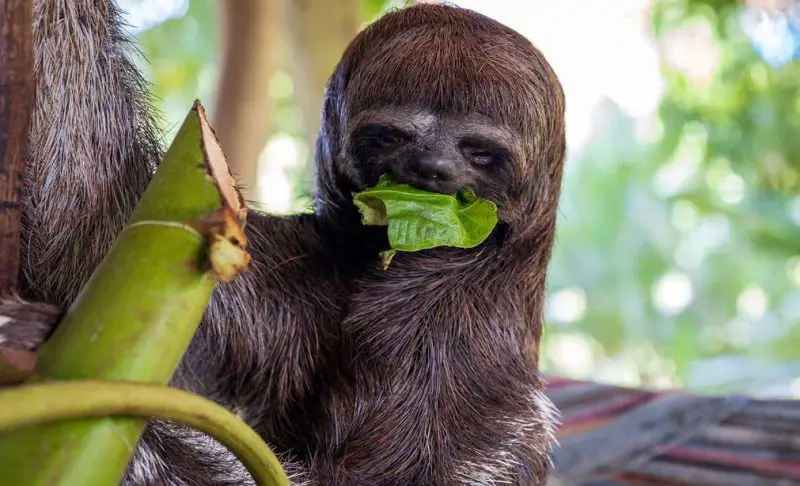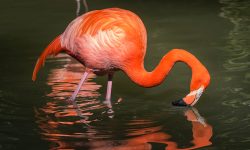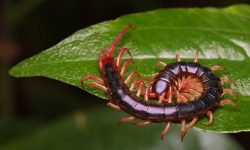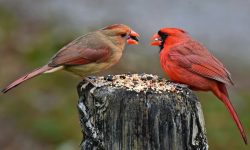Sloths move through tropical forests with a calm, unhurried rhythm that makes them seem almost disconnected from the fast pace of life around them. But while their movements may be slow, their feeding habits are surprisingly complex. Understanding what sloths eat reveals how these gentle mammals survive in dense rainforests and why their diet is so deeply tied to the trees they depend on. Their food choices influence their energy levels, behavior and even the specialized microbes in their stomachs.
Sloths spend nearly their entire lives in the canopy, where they carefully select leaves, fruits and flowers that provide the nutrients they need. Because leaves are low in energy, sloths have evolved a slow metabolism that allows them to conserve calories. Their stomachs are uniquely adapted to break down tough cellulose-rich food that most mammals cannot digest. This slow but efficient lifestyle is what allows sloths to thrive where food is abundant but not particularly nutrient-rich.
This article explores 20 foods sloths forage for in the wild, offering a deeper look into their diet and the ecological relationships that support them. Their food sources reflect the environment of Central and South American forests, where sloths live quietly among branches and foliage.
Understanding the Sloth Diet

Sloths are primarily folivores, meaning their diet is dominated by leaves. However, they also eat fruits, flowers, buds and occasionally insects or soil when specific nutrients are needed. Their slow metabolism is key to their survival. Digesting leaves can take days or even weeks, so sloths rely on a multi-chambered stomach filled with specialized bacteria that ferment tough plant material and extract nutrients gradually.
Because not all leaves provide the same nutritional value, sloths are highly selective. They sample leaves from dozens of tree species but often rely heavily on just a few preferred ones. These chosen species tend to have lower toxins and easier-to-digest fibers. Their diet can vary by region, season and forest type, reflecting local plant availability.
Sloths also hydrate differently than many mammals. Rather than drinking water frequently, they obtain most of their moisture from the leaves and fruits they consume. In rainy seasons, sloths may lick moisture from leaves or absorb hydration directly from the vegetation around them. This feeding strategy allows them to remain high in the canopy, reducing the danger of descending to the forest floor.
20 Foods Sloths Forage for in the Wild
1. Cecropia Leaves
Cecropia trees are among the most important food sources for sloths. Their leaves are soft, relatively low in toxins and easy to digest compared to other rainforest foliage. Cecropia species grow quickly, offering sloths a steady supply year-round.
Sloths often remain in Cecropia trees for long periods, feeding slowly on fresh leaves. The trees’ open structure makes climbing easier, reducing energy expenditure.
Because Cecropia trees thrive near forest gaps, sloths are commonly seen feeding in these sunny areas.
2. Hibiscus Leaves
Hibiscus leaves provide hydration and mild nutrients. Their soft texture makes them easier to handle and digest. Sloths forage for hibiscus near forest edges and within secondary growth.
These leaves contain natural compounds that support digestion and maintain healthy gut function. Sloths eat young leaves more often because they require less energy to process.
During drier periods, hibiscus leaves become especially valuable due to their moisture content.
3. Fig Leaves
Fig trees are widespread in rainforests, and sloths frequently consume their leaves. Fig leaves contain minerals and provide sustained energy despite being somewhat tough.
Sloths often visit fig trees not only for leaves but also for the fruits and buds. Their adaptability to fig species helps ensure a consistent food supply.
Because fig trees grow tall, they offer safe feeding zones away from predators.
4. Mango Leaves
Wild mango trees produce thick leaves that sloths occasionally consume. While not as soft as other leaves, mango foliage provides essential nutrients and hydration.
Sloths typically feed on young mango leaves, which are lighter and less fibrous. These leaves grow abundantly in warm tropical climates.
Mango trees also attract insects and other small creatures that sloths may opportunistically consume.
5. Guava Leaves
Guava leaves offer medicinal properties and mild nutritional value. They contain tannins that may help sloths maintain healthy digestion.
Sloths forage for guava leaves in lowland forests where guava grows naturally. These leaves are usually eaten sparingly as part of a varied diet.
Young guava shoots are preferred because they are softer and easier to digest.
6. Almond Tree Leaves
Wild almond trees produce broad leaves that sloths sometimes eat. These leaves provide minerals and support hydration during warm months.
Sloths select almond leaves carefully, often choosing the youngest ones with the lowest fiber content. Almond branches are strong and offer comfortable resting spots.
Their thick canopy structure makes it easy for sloths to hide and feed without descending.
7. Mulberry Leaves
Mulberry leaves are nutrient-rich and provide a balanced combination of proteins and carbohydrates. Sloths encounter mulberry trees in certain forest regions.
The leaves’ soft texture makes them a comfortable choice for slow digestion. Sloths often spend longer feeding bouts in mulberry trees.
Mulberry leaves also contain antioxidants that may support sloth immune health.
8. Yagrumo Leaves
Yagrumo, related to Cecropia, produces soft, large leaves that sloths favor. These leaves absorb water easily, keeping sloths hydrated.
Sloths often rest and feed in yagrumo trees simultaneously, conserving energy. Their availability in humid environments makes them a dependable resource.
The leaves’ nutritional profile matches the low-energy lifestyle of sloths.
9. Young Buds
Sloths eat young buds from various tree species. Buds provide concentrated nutrients and soft textures that are easier to digest than mature leaves.
Because buds emerge seasonally, sloths take advantage of them during growth periods when trees produce new foliage. These foods offer a temporary boost in nutritional intake.
Buds are often consumed early in the morning when moisture content is highest.
10. Tender Shoots
Shoots help diversify a sloth’s diet. They contain water, minerals and mild sugars that support metabolic needs. Sloths often strip shoots from branches using gentle bites.
Sloths target shoots during wet seasons when plant growth accelerates. Their selective feeding ensures the plant continues to grow.
Because shoots grow close to resting positions on branches, they require minimal movement to access.
11. Flowers
Flowers provide nectar, pollen and soft petals that offer energy and hydration. Sloths gently pull flowers from branches and chew them slowly.
Flower availability changes seasonally, but sloths take advantage of blooming periods to diversify their diet. The sweet flavor encourages occasional consumption.
Some flowers contain calming compounds that may support the sloth’s naturally slow behavior.
12. Fruits
Although sloths primarily eat leaves, fruits become valuable supplements when available. They are naturally hydrating and energy-rich.
Sloths typically prefer small, soft fruits such as figs, guava and wild berries. These fruits offer quick sugars that support daily activity.
Fruit consumption increases during rainy seasons when options are wider.
13. Seed Pods
Sloths occasionally consume the tender inner portions of seed pods. Although high in fiber, certain pods contain nutrients that sloths use sparingly.
Pods are usually eaten when other foods become harder to reach. Sloths chew carefully to avoid tougher outer casings.
Seed pods add variety but are not a major food source.
14. Moss
Moss growing on branches forms an incidental part of the sloth’s diet. As sloths move slowly, they often lick or chew moss patches without deliberate effort.
Moss provides moisture and trace minerals. It is abundant in humid forests where sloths spend most of their time.
This food is not nutrient-dense but contributes consistent hydration.
15. Lichens
Lichens are slow-growing organisms that cover tree bark. Sloths sometimes eat them while climbing or resting. Lichens contain minerals and mild carbohydrates.
Their availability on high branches makes them convenient for sloths that prefer to avoid descending. Lichens’ fibrous structure aligns with the sloth’s digestive adaptations.
These organisms support sloths during periods when fresh leaves are limited.
16. Bark Strips
Sloths peel thin strips of bark when food is scarce. Bark provides minimal nutrients but contains moisture and minerals.
This behavior is more common during dry seasons when young leaves are harder to find. Sloths carefully nibble soft inner bark to avoid tougher outer layers.
Bark is considered a survival food rather than a dietary staple.
17. Soil (Mineral-Rich)
Sloths occasionally consume soil to obtain minerals that support digestion and overall health. This behavior, known as geophagy, helps neutralize plant toxins.
Sloths lick small amounts of soil from tree trunks or exposed roots. The minerals help balance their nutrient intake.
Soil consumption is infrequent but plays a valuable role in their digestive strategy.
18. Ants
Although sloths are not insectivores, they may eat ants incidentally while consuming leaves. Ants offer small amounts of protein.
Because ants live on leaves and branches, sloths encounter them regularly. Their slow tongue movements make insect consumption unintentional but beneficial.
This adds a trace amount of animal protein to their fiber-heavy diet.
19. Small Beetles
Beetles on leaves or bark sometimes become part of the sloth’s diet. Their presence is incidental rather than intentional.
These insects contribute minimal protein but support digestive diversity. Sloths rarely seek them out actively.
Beetles are more common during wet seasons and may be consumed more frequently then.
20. Algae from Fur
Sloths host algae that grow naturally in their fur due to humidity. Occasionally, they lick their fur and ingest small amounts of algae.
This provides trace nutrients and acts as a mild supplement. The algae also help camouflage the sloth within the forest canopy.
This unusual food source reflects the unique relationship sloths have with their environment.
FAQs About What Do Sloths Eat
What do sloths eat most often?
Primarily leaves, especially from Cecropia and similar trees.
Do sloths eat bananas in the wild?
No. Bananas are not part of their natural diet.
Do sloths drink water?
Rarely. They get hydration from leaves and fruits.
Can sloths eat insects?
Occasionally and unintentionally, but insects are not a major food.
Do sloths eat flowers?
Yes, especially during blooming seasons.
Do sloths have a slow metabolism?
Yes. Their metabolism is among the slowest of any mammal.
How long do sloths take to digest food?
Up to several days or weeks.
Do sloths eat bark?
Only occasionally when other foods are scarce.
Are sloths herbivores?
Primarily, though their diet includes incidental insects.
What foods are essential to sloth survival?
Soft leaves, buds and shoots from rainforest trees.
Final Thoughts
Sloths may seem simple, but their diet reflects remarkable adaptations to life in dense rainforest canopies. By understanding what sloths eat, we gain insight into their slow metabolic rhythms, selective feeding habits and intimate connection to the trees that support them. From tender leaves and flowers to occasional insects and algae, their food choices reveal a lifestyle built on conservation, patience and balance. Protecting the forests they depend on ensures that these gentle creatures continue to thrive high above the ground.






